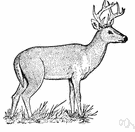white-tailed deer
Also found in: Thesaurus, Wikipedia.
Related to white-tailed deer: black-tailed deer
white-tailed deer
(wīt′tāld′, hwīt′-)n.
A North American deer (Odocoileus virginianus) having a coat that is grayish- or reddish-brown, a tail that is white on the underside, and many-branched antlers in the male. Also called Virginia deer, whitetail.
American Heritage® Dictionary of the English Language, Fifth Edition. Copyright © 2016 by Houghton Mifflin Harcourt Publishing Company. Published by Houghton Mifflin Harcourt Publishing Company. All rights reserved.
white-tailed deer
orwhitetail
n
(Animals) a deer, Odocoileus virginianus, of North America and N South America: the coat varies in colour, being typically reddish-brown in the summer, and the tail is white. Also called: Virginia deer
Collins English Dictionary – Complete and Unabridged, 12th Edition 2014 © HarperCollins Publishers 1991, 1994, 1998, 2000, 2003, 2006, 2007, 2009, 2011, 2014
white′-tailed`
(or white′tail) deer′,
n.
a North American deer, Odocoileus virginianus, having a tail with a white underside.
Also called white′tail`..[1840–50, Amer.]
Random House Kernerman Webster's College Dictionary, © 2010 K Dictionaries Ltd. Copyright 2005, 1997, 1991 by Random House, Inc. All rights reserved.
ThesaurusAntonymsRelated WordsSynonymsLegend:
Switch to new thesaurus
| Noun | 1. |  white-tailed deer - common North American deer; tail has a white underside white-tailed deer - common North American deer; tail has a white undersidegenus Odocoileus, Odocoileus - North American deer |
Based on WordNet 3.0, Farlex clipart collection. © 2003-2012 Princeton University, Farlex Inc.
